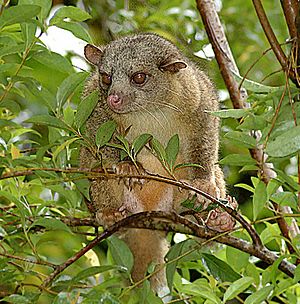Northern olingo facts for kids
Quick facts for kids Northern olingo |
|
|---|---|
 |
|
| in Costa Rica | |
| Conservation status | |
| Scientific classification | |
| Genus: |
Bassaricyon
|
| Species: |
gabbii
|
 |
|
| Northern olingo range | |
| Synonyms | |
|
Bassaricyon richardsoni J. A. Allen, 1908 |
|
The northern olingo (Bassaricyon gabbii) is a small animal that lives in trees. It is also known as the bushy-tailed olingo. It belongs to the raccoon family, which includes animals like coatimundis and kinkajous.
Northern olingos live in Central America. It was the first type of olingo that scientists studied. Some people thought it was the only "true" olingo species. However, scientists later found there are actually four different olingo species. The northern olingo was named after William More Gabb. He was the first person to find and collect a specimen for Western science.
Contents
What Does the Northern Olingo Look Like?
The northern olingo is a slim animal that lives in trees. Its back legs are longer than its front legs. It has a long, bushy tail. Its face is short and round, with big eyes and small, round ears.
Its fur is thick and usually brown or grey-brown. The fur is a bit darker along its back. Its belly is light cream or yellowish. A band of yellowish fur goes around its throat and sides of its head. The fur on its face is greyish. Its tail is the same color as its body. It has faint rings of darker fur along its tail.
The bottoms of its feet are hairy. Its toes are slightly flat, with short, curved claws. Female olingos have one pair of teats near their back legs.
Adult northern olingos are about 36 to 42 centimetres (14 to 17 in) long from head to body. Their tails are about 38 to 48 centimetres (15 to 19 in) long. They weigh around 1.2 to 1.4 kilograms (2.6 to 3.1 lb). Northern olingos have special scent glands. These glands can make a bad-smelling chemical if the animal feels scared.
This olingo is the biggest of all the olingo species. Its fur is usually less reddish than other olingos. Its tail rings are also a bit clearer to see.
Where Do Northern Olingos Live?
Northern olingos are found from Nicaragua south through Colombia. They also live in Costa Rica and Panamá. They have sometimes been seen in Honduras and Guatemala. However, they look very much like the more common kinkajou. This makes some of those sightings uncertain.
The IUCN lists the northern olingo as "Least Concern" (LC). This means it is not currently in danger of extinction.
Northern olingos usually live in montane forests and tropical moist forests. These are forests found on mountains. They live at heights from 1,000 metres (3,300 ft) up to about 2,000 metres (6,600 ft). They seem to avoid areas where humans have disturbed the forest. They also avoid farms or areas with new, young forests.
How Scientists Study Olingos
Scientists group animals based on how they are related. The northern olingo's closest relatives are two other olingo species. These are B. alleni and B. medius. They live in Panama and northwestern South America. These species separated from the northern olingo about 1.8 million years ago.
Diet and Behavior
The northern olingo is a nocturnal animal. This means it is active mostly at night. It is a herbivore, which means it eats plants. It mostly eats fruit, especially figs. During the dry season, it has been seen drinking nectar from balsa trees. Sometimes, it might eat small mammals like mice or squirrels. During the day, it sleeps in dens inside large trees. An olingo's home area is about 23 hectares (57 acres) big.
Even though people thought olingos lived alone, they are often seen in pairs. They might be more social than we thought. They spend most of their time in trees. Their tail is not prehensile. This means they cannot use it to grab things, unlike the kinkajou. However, their tail helps them balance. The northern olingo's call sounds like "whey-chuck" or "wey-toll."
Northern olingos eat similar foods and live in similar places as kinkajous. If there isn't enough food, the larger kinkajou might chase the olingo away from its favorite trees. Animals that hunt northern olingos include the jaguarundi, ocelot, tayra, and several types of boas (snakes).
Reproduction and Life Cycle
Scientists believe northern olingos breed during the dry season. A female olingo usually gives birth to one baby. The baby develops inside the mother for about ten weeks. In zoos, northern olingos have lived for up to twenty-five years.


